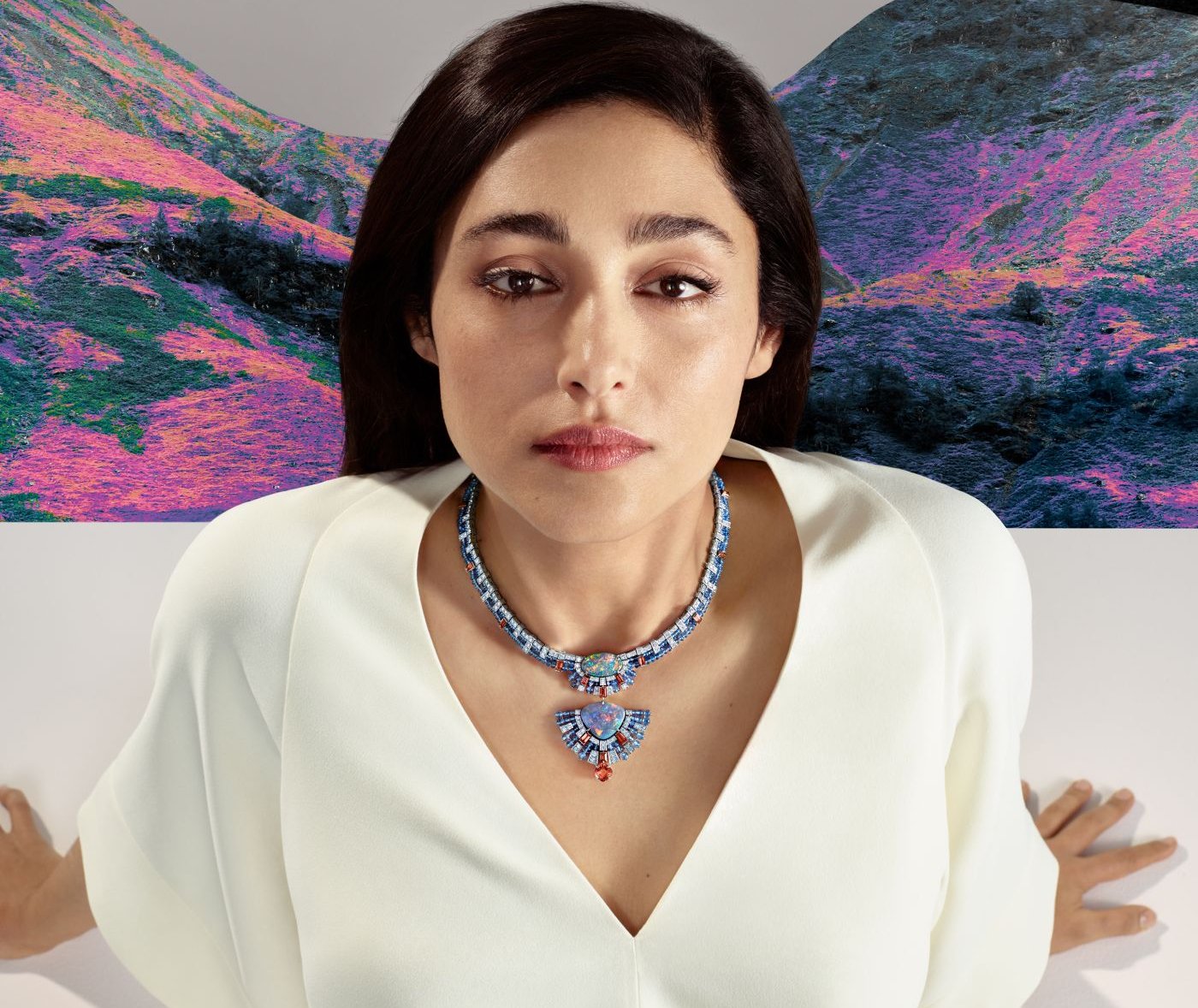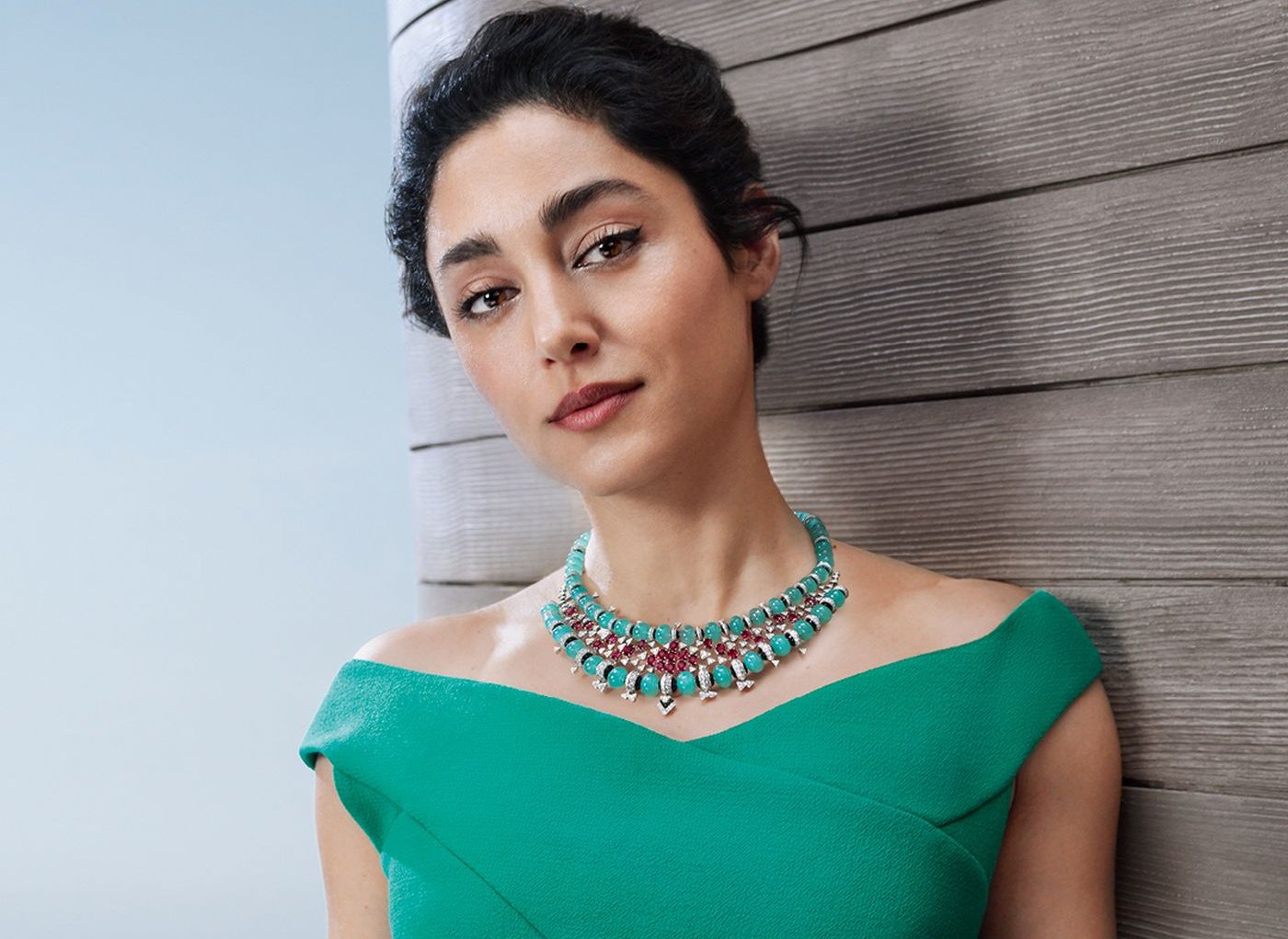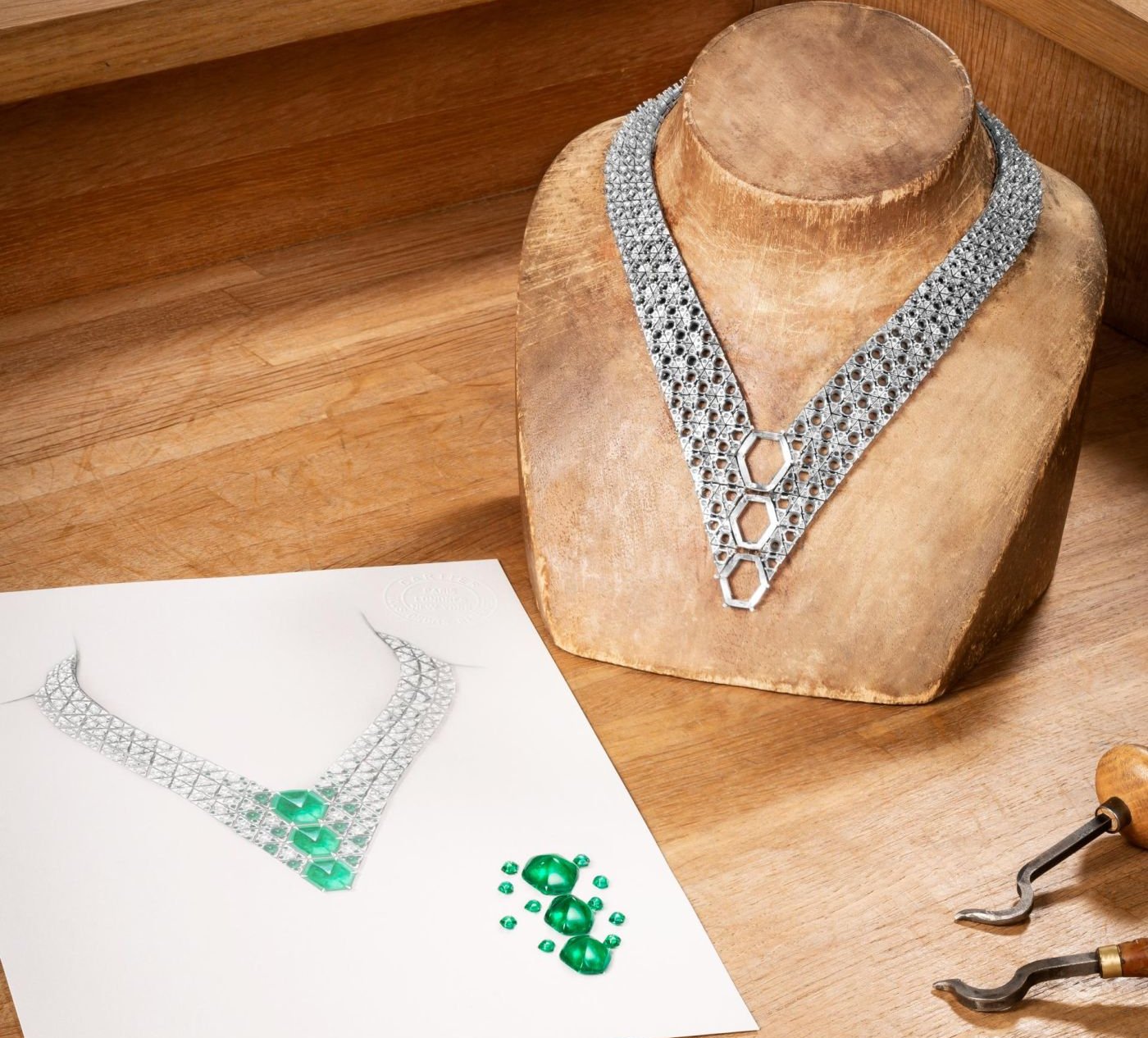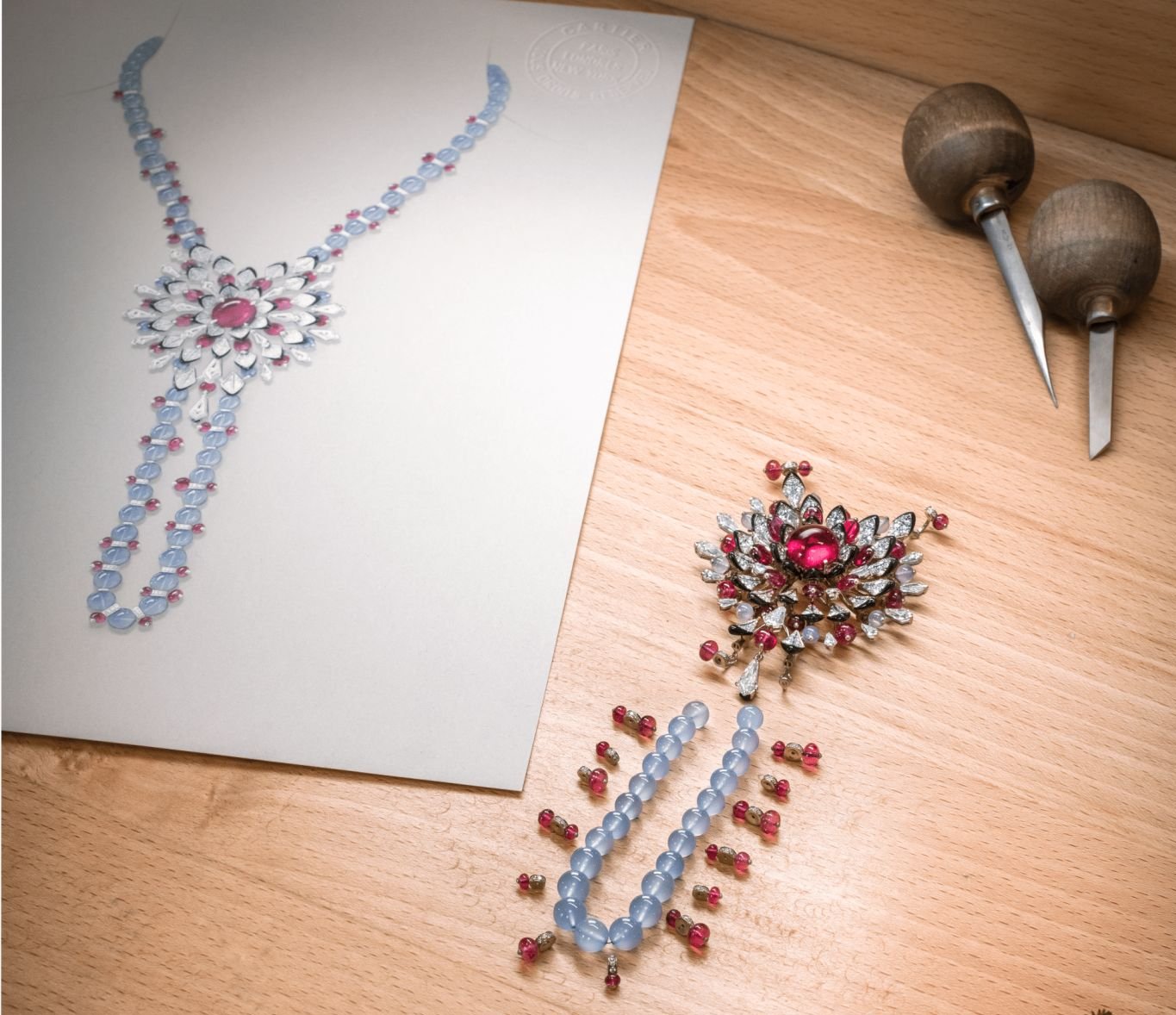ouchali is the miracle of an aquatic flower, whose beauty Cartier captures. A stylised approach to a water lily, whose jewellery composition is akin to a sculpture. The eye is immediately captivated by the centre stone, a 10.61-carat rubellite, around which diamond petals surrounded by onyx unfold, amplifying the impression of volume. They are all geometrically shaped, emblematic of Cartier High Jewellery.
Everything is articulated to form a bright architecture similar to the back of a stained glass rose window. The blossoming of life is further enhanced by the use of the “trembling” setting, which animates the petals by allowing them to vibrate slightly at the slightest movement.
Inspired by the marine ecosystem, the Recif necklace celebrates the beauty of coral reefs. A living organism, somewhere between flora and fauna, stylised as such by the jeweller. Cartier evokes emerald and coral contrasts in the form of ribbed beads snaking along a diamond atoll.
The rhythm is set by Cartier’s emblematic combination of the orange of the coral and the green of the emerald.
This intense chromatic contrast is further enhanced by the twisting movement given to the coral and emerald beads, which allow the white sparkle of the diamonds to filter through. This luscious composition of stones cut into ribbed beads and studded with emerald or amethyst cabochons is unmistakeably the Maison’s style. Cartier reinterprets it here, defying its expertise so that the winding of the beads does not in any way impede the comfort of the wearer. It is a question of proportion, striking a balance between the smallest and the largest of them.
Water aspis is one of the most mythical creatures in the Cartier menagerie, where it instils its voluptuous charm. A powerful and hypnotic snake whose beauty and incredible flexibility Cartier enhances through this new interpretation. An expression of Cartier style, this snake is at the crossroads of major influences for the Maison, between realism, stylisation and abstraction.
Realism is the expression of volume as close to reality as possible; the art of capturing the snake’s energy, its sinuosity, its ability to coil around its prey. This realism is further accentuated by the attention the Maison pays to the joints, a crucial factor of Cartier detail that allows the necklace to be completely mobile.
Five spectacular 43.49-carat ceylon sapphire cabochons that punctuate the body of the necklace with an intense blue.

Abstraction is the ability to imagine a pattern of triangular diamond and lapis lazuli scales based on a succession of geometric shapes, featuring openwork between them to maximise the brilliance of the stones.
Take a close look at a butterfly wing, let yourself be dazzled by the beauty of its shades, and imagine an embellishment that would reflect its iridescent beauty. This is how the Apatura necklace was born, from the observation of the infinitely small. And what better than the rainbow nuances of opal to convey its vivacity and brilliance. Three Australian opals weighing 22.08 carats are framed by geometrical motifs composed of diamond bars and blue sapphire beads whose shade of colour echoes the opal’s fire.
Here, it is not a question of reproducing a butterfly figuratively, but of suggesting it through an abstract composition, a display of shimmering colours that evoke the idea of the most marvellous of insects from far and wide. As a colourist, Cartier draws on its jewellery palette of bright colours to design a graphic and contrasting fan vertically aligned with a necklace that is rigid in appearance, but incredibly supple.
Cartier pays tribute to the beauty of embellishments, and more specifically to traditional Mesoamerican jewellery, with the Rituel set. Composed of a double row of azure chalcedony beads the necklace unfolds to showcase an iridescent constellation of rubies. Subtle and delicate, the patterns alternate between diamond cones and faceted rubies that seem to hang without any link between them through an invisible setting.

Cartier relies on the effects of symmetry and parallelism, which give rhythm to the composition.
A graphic rigour feminised by the soft turquoise of a spectacular set of cabochon-cut chalcedony. In the great stylistic tradition of the Maison, the contrasts are strong and bold. It is the choice of pink and blue, two soft and joyful colours whose contours Cartier surrounds with the intense black of onyx.
The rare, the singular... For Cartier, Beauty is everywhere. It has inspired the jeweller to create a new repertoire of seven rings within the collection.
A capsule collection that takes the eye on a journey from the depths of the sea to the far reaches of the sky. The incredible wealth of the universe is concentrated in each piece, on their own scale and as if in miniature.
Designed as if they were sculptures, they form a family of styles. Together, they cover all the Maison’s major areas of expression: geometry, movement, colour contrasts, flora and fauna.
A carapace from a drawing in an old biology book; a sea dragon, Homer’s mythological creature; an ammonite fossil; a sea monster; an asteroid; a geological crystallisation; a Chinese puzzle... All these rings form a composite inventory enhanced by the interplay of stones.

Triangular diamonds, purple spinels, cabochon tourmalines or green diamonds: the stones in each of the rings, beloved by the Maison for their extra touch of soul, are a testament to the originality of Cartier’s choices.
Texture, dimension, it is the skin of the green iguana that inspired the Maison’s design studios to create this set. It reveals its beauty through a necklace Iwana abundant with diamonds and emeralds.
Everything is based on the suppleness and subtle sinuosity of the setting, which evokes the shifts and motion of the animal’s skin. Cartier emphasises texture by relying on the fullness and emptiness of a geometric succession of diamond-paved triangles, creating an open-work between each other that echoes the facets of three spectacular Colombian emeralds weighing 43.45 carats. Emblematic of Cartier’s expertise and style, their four-sided cut is shaped to be reminiscent of the animal’s dorsal spines.
In addition to the high jewellery collection composed of unique pieces, Cartier has created a jewellery collection made up of three sets, which in turn pay tribute to the beauty of the world.
Cartier has been interested in animal furs and coats for over a century. For this original necklace, it is zebra stripes that lend themselves to a stylised interpretation. On the chain, the motif is completely abstract, evoked only by alternating diamonds, onyx tubes and rubellite punctuations. Just like the shapes, the chromatic palette of onyx and rubellite – emblematic of Cartier’s style for over a century – structures the composition and gives it a powerful rhythm.
Cartier perceives the aesthetic power of nature in its smallest details, transposed into abstract creations. Here, the Maison has been loosely inspired by a palm tree, a figure already present in its repertoire, as proven by the creation of a ruby brooch in 1957. The trunk lends its slender shape to the long necklace, while the large rubellite beads evoke delectable fruit. By playing with multiplication, the design gives way to a highly graphic composition, thanks in particular to the red and black contrast emblematic of Cartier.

For this set, Cartier interprets a naturalistic motif: the butterfly. The insect’s wing – as if observed from up close – is fragmented and multiplied into a completely abstract composition. The design is a play on the different possibilities offered by this single motif. In a colour scheme that has been dear to the Maison for more than a century, touches of onyx and rubellite underscore the balance of the whole and add depth.
Capturing the beauty of the world, looking at it through a spectrum of colours, shapes and evocative materials, inspires and transports us.











